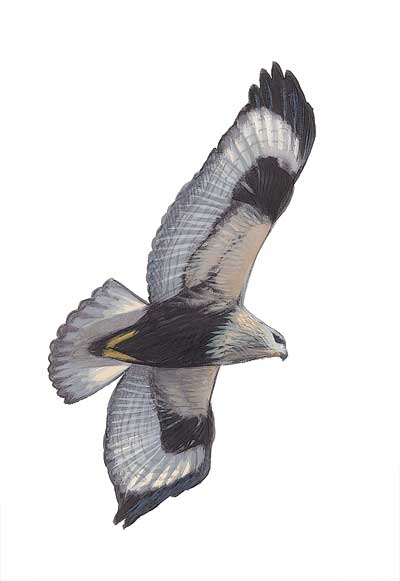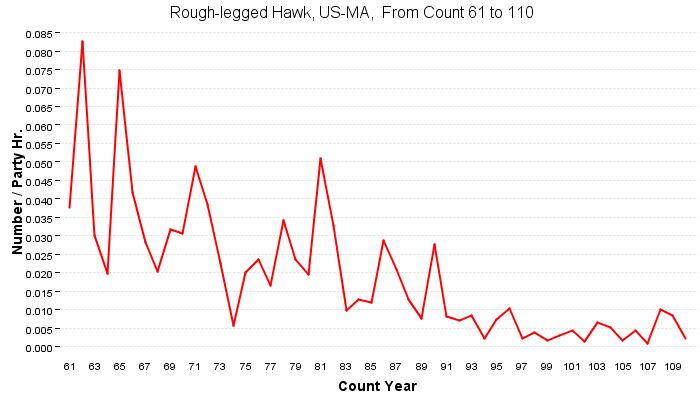
The other morning I was passing a farm field near my house. It’s a place where I often go birding and as I glanced around I was thinking “maybe there could be a Rough-legged Hawk today”. But I’ve never seen a Rough-legged Hawk here in 12 years in the neighborhood, and all I could see was one of the resident Red-tails. And I realized that if any Rough-legged Hawk was passing by and paused to hunt over this field, the resident pair of Red-tailed Hawks would probably chase it away immediately.
Anyone who has been birding in the northeast for more than a decade has noticed the increase in Red-tailed Hawks. They have adapted to the suburbs and increased in numbers steadily for at least 50 years, becoming a widespread and omnipresent part of the avifauna.
These Red-tails are mostly resident. As long as they have enough food, pairs of adults remain on their territories and aggressively defend them year-round. In the same fifty year period the number of Rough-legged Hawks found on Christmas Counts in Massachusetts has declined dramatically.
A similar pattern shows in other Northeastern states, but in Manitoba and nearby states and provinces, where Red-tailed Hawks are not resident, the number of Rough-leggeds found on Christmas Counts has increased over the last fifty years.


A similar sort of displacement was the leading hypothesis for the decline of Purple Finch in the northeast. They were being “outcompeted” by introduced House Finches, so the story went, but I don’t think there’s any evidence to support that. The increase of very aggressive Mute Swans in the northeast may be leading to declines of other nesting waterfowl. There are presumably other examples of this kind of interaction between species.
The number of Rough-legged Hawks wintering in Massachusetts was always small, so changes here are probably not significant to the species as a whole, and I’m not suggesting that there is any cause for alarm or action. It’s possible that the decline of Rough-leggeds here has more to do with the well-documented loss of open farmland and increasing forest cover in the last few decades. I’m just curious.
Have you noticed interactions between Red-tailed Hawks and wintering Rough-legged in your area? Do Rough-legged Hawks and resident Red-tails coexist anywhere? Is there any place Rough-legged Hawks have declined where Red-tails are not resident?
Graphs are from the Audubon Christmas Bird Count website at http://birds.audubon.org/historical-results


On Saturday February 11 during a local Raptor Count (Roanoke Valley Birdclub) Dave Brunstetter and I saw and identified a Rough-legged in a field three miles north of Exit 168 on I-81 at Acradia Virginia. We have excellent photos of the bird. Yesterday I was at the same location hoping to spot the it a second time. I did so. The Red Tail are numberous in the area but I didn’t observe any altercations. I counted it a privileged to just view that single Rough-legged. They are magnificent flyers.
This winter I conducted wintering raptor surveys in south central Utah. I saw a great deal of Rough-legged Hawks, and Red-tailed Hawks. During my surveys, I never saw any interaction save one agriculture field off of the interstate where multiple birds including Ferruginous Hawks were hanging out. These were all probably migrants, as most of the resident RT’s stay in the backcountry where their territories exist. Another area full of wintering birds (including Harlan’s) is an area in Lehi, Utah that sits right along the interstate. While photographing birds there one day in January, I observed two young birds, a RT and RL performing arial maneuvers. They had multiple interactions, none of which seemed aggressive. Among young wintering birds I assume this is no rarity. If food was scarce in the area, and the resident bird was present, I assume things would be different. Obviously the food was a plenty due to the number of birds that hang out in the area. Great post, and great painting as well.
In the agricultural landscape northwest of Waterloo, Ontario we have a large wintering population (~100 of each species on the Linwood CBC) of both Rough-legged Hawks and Red-tailed Hawks each year. The Red-tailed Hawks include year round residents (usually remain loosely paired up through winter and in the vicinity of nest sites) and migrants from further north. They certainly seem to coexist here fairly well. The Linwood CBC hasn’t been running long enough to get a sense of whether Rough-legged Hawks are declining but from my personal observations over the last 20 years I’d say they are pretty steady. It should be noted that the Linwood CBC regularly has the highest count for Rough-legged Hawks in the east.
I can’t think of many interactions between the two species in that area but I do have a sequence of photos documenting a Rough-legged Hawk attempting to push a Red-tailed Hawk off of a prey item (not sure what it was) from Long Point, Norfolk County, Ontario. The Red-tailed Hawk successfully defended the would-be robber and the Rough-legged Hawk eventually retreated.
My wife and I were driving through Glen Allan, Ontario on the way to Waterloo, Ontario. I spotted 2 hawks circling. I pulled over to take a photo. One of the hawks flew off out of range before I stopped and got out of the car. I got a few photos of the second hawk in flight and discovered it was a rough-legged hawk when reviewing the photos.
On August 3, 2014 in Quincy Mass, I viewed what I believed t be a Rough Legged Hawk in my back yard, capture another animal, stand on it for a solid minute, then fly low and fast through the trees till it had space to soar upward. The only creature that I could find that matched the physical description of what I saw is the Rough Legged Hawk. Any and all please advise….
I volunteer at a raptor rehabilitation center in Maryland. On February 20th we took in a juvenile dark morph RLHA found not far from Frederick. It’s the first we’ve seen at the center or in the wild in this area. It’s a beautiful bird and as always we’re hopeful for a full recovery and eventual release. Unfortunately due to the severity of the injuries, the prognosis is guarded. We do thank the person who picked up the injured hawk and all those who take the time to really observe and interact with the world around them.
I’m in south end of the Mission Valley in St. Ignatius Western Montana. We often see rough leggeds move into this valley for the winter. I see no less numbers of our resident red tails, they seem to co exist.
In Northeastern Washington State, Kettle River Range area, rough-legged hawks winter over within the valleys populated by our resident Red-tails, who are more prolific. Haven’t noted any altercations when I’m out several times weekly birding and photographing.
We have both in the winter. We even had an interesting ‘pair’- dark morph of both for at least two winters spending time just a few hundred yards apart for most of the winter- Finley Road in the William Finley Refuge south of Corvallis, OR. I’ve been able to get very nice photos of both, Sitting, both are just about completely dark- nothing light showing.
The Rough-legged dark morph that I mentioned is in this group of shots- https://www.flickr.com/search/?user_id=23083154%40N02&view_all=1&text=Rough-legged
I have an still do hunt an area of land in North East Louisiana that is in the Parish of Tensas. I have noticed through the last decade a larger number of prey birds that I don attribute to the local species of “chicken hawks” (cooper’s or redtails) and have been wondering what they are. Seem to be a little larger than the redtail variety with dark plumage all the way through except underbelly wing tips and tail feathers. I know we have a population of eagles in the area but don’t believe these are juvenile eagles I’m seeing.
Interested on you guys thoughts and please reach to me with any ideas.